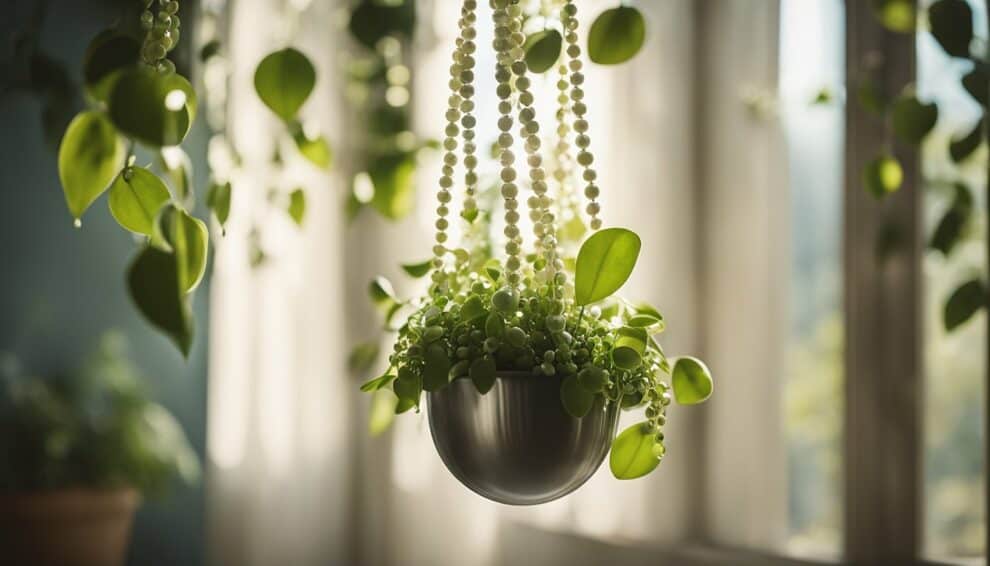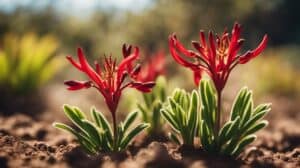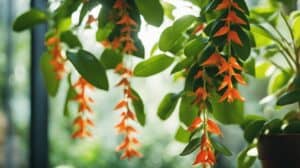String of pearls (Senecio rowleyanus) is a popular trailing succulent that is native to South Africa.
This plant is known for its unique appearance, as it features long, thin stems that are adorned with small, spherical leaves that resemble pearls.
While string of pearls is a relatively easy plant to care for, many gardeners are curious about how to propagate it.
In this article, we will explore the topic of string of pearls propagation and provide some simple tips and tricks for growing new plants from cuttings.

One of the main reasons that gardeners are interested in propagating string of pearls is because it can be difficult to find in nurseries or garden centers.
Additionally, propagating this plant can be a fun and rewarding way to expand your collection of succulents.
There are several methods for propagating string of pearls, including stem cuttings, leaf cuttings, and division.
Each method has its own advantages and disadvantages, and we will discuss these in more detail later in the article.
Whether you are a seasoned succulent grower or a beginner, learning how to propagate string of pearls can be a valuable skill that will allow you to enjoy this unique plant for years to come.
Understanding Senecio Rowleyanus
Senecio Rowleyanus, commonly known as String of Pearls, is a succulent plant that is native to South Africa.
It is a popular houseplant due to its unique appearance and ease of care.
The plant is characterized by its long, trailing stems that are adorned with small, round, bead-like leaves that resemble pearls.
The leaves of the Senecio Rowleyanus are green, but they can turn yellow if the plant is overwatered or exposed to too much direct sunlight.
The plant can grow up to 3 feet long and is best grown in a hanging basket or container where its trailing stems can be displayed.
Senecio Rowleyanus is a low-maintenance plant that is easy to propagate.
The plant can be propagated by stem cuttings or by separating the plant into smaller sections.
The cuttings should be allowed to dry for a day or two before being planted in well-draining soil.
When caring for Senecio Rowleyanus, it is important to avoid overwatering the plant as this can cause root rot.
The plant should be watered only when the soil is completely dry.
The plant also prefers bright, indirect sunlight and should be kept away from direct sunlight.
In conclusion, Senecio Rowleyanus is a unique and easy-to-care-for houseplant that is perfect for adding a touch of greenery to any space.
With proper care and propagation techniques, this plant can thrive and provide years of enjoyment.
Preparation for Propagation

Selecting Healthy String of Pearls Cuttings
Before propagating a String of Pearls plant, it is important to select healthy cuttings.
Look for cuttings that have plump, round leaves and no signs of damage or disease.
Cuttings that are too small or too large may not root properly, so aim for cuttings that are about 2-3 inches in length.
Gathering Required Supplies
To successfully propagate a String of Pearls plant, you will need a few supplies. These include:
- A clean, sharp pair of pruning shears
- A container filled with well-draining soil or a rooting medium
- A spray bottle filled with water
- Optional: rooting hormone
Make sure to sterilize your pruning shears before using them to prevent the spread of disease.
A rooting medium that is too dense or retains too much moisture can lead to rot, so choose a well-draining soil or mix in perlite or sand to improve drainage.
The spray bottle will be used to mist the cuttings to keep them hydrated during the rooting process.
Rooting hormone can help speed up the rooting process, but is not necessary.
By selecting healthy cuttings and gathering the necessary supplies, you will be well on your way to successfully propagating your String of Pearls plant.
Propagation Techniques

Soil Propagation Method
The soil propagation method is the most common way to propagate string of pearls. To start, fill a small pot with well-draining soil, such as cactus mix.
Next, carefully take a cutting from the mother plant, making sure it has a few healthy leaves and a stem.
Allow the cutting to dry for a few days until the cut end has calloused over. Then, plant the cutting in the soil, burying the bottom half of the stem.
Water the soil thoroughly and place the pot in a bright, indirect light.
Keep the soil moist but not waterlogged, and within a few weeks, the cutting should take root and begin to grow.
Water Propagation Method
Water propagation is another popular method for propagating string of pearls.
To start, take a cutting from the mother plant and allow it to dry for a few days until the cut end has calloused over.
Then, place the cutting in a jar or vase filled with water, making sure the bottom of the stem is submerged.
Place the jar in a bright, indirect light and change the water every few days to prevent the growth of bacteria.
Within a few weeks, the cutting should develop roots, and once the roots are a few inches long, it can be planted in soil.
Both soil and water propagation methods have their advantages and disadvantages.
Soil propagation is more reliable and produces stronger plants, while water propagation allows you to watch the roots develop and adjust the water level as needed.
Regardless of the method chosen, with patience and care, anyone can successfully propagate string of pearls and enjoy this unique and beautiful plant.
Post-Propagation Care

After successfully propagating a string of pearls plant, it is important to provide the right care to ensure its growth and health.
This section will cover the initial care and environment needed for the newly propagated plant, as well as the long-term maintenance required for its continued growth.
Initial Care and Environment
Once the string of pearls has been propagated, it is important to move it to a suitable environment.
The new plant should be placed in a bright, indirect light location, away from direct sunlight.
Direct sunlight can cause the plant to dry out and burn, so it is important to avoid placing it in such an area.
The plant should be watered sparingly, as overwatering can lead to root rot and damage the plant.
It is recommended to water the plant once a week, allowing the soil to dry out between watering sessions.
This will prevent the soil from becoming too damp and causing damage to the plant.
Long-Term Plant Maintenance
As the string of pearls plant grows, it will require regular maintenance to ensure its continued health and growth.
The plant should be repotted every two years, or when it outgrows its current container.
When repotting, it is important to use a well-draining soil mix to prevent water from accumulating in the pot and causing damage to the plant.
Regular pruning is also necessary to maintain the plant’s shape and prevent it from becoming too leggy.
Pruning should be done by snipping off the ends of the stems, just above a leaf node.
This will encourage new growth and help the plant to maintain its shape.
In addition to regular pruning, the plant should also be fertilized every two to three months during the growing season.
This will provide the necessary nutrients for the plant to grow and thrive. It is recommended to use a balanced, water-soluble fertilizer for best results.
By providing the right care and maintenance, a string of pearls plant can thrive and grow for many years to come.
Frequently Asked Questions

How do I begin propagating a String of Pearls plant?
To propagate a String of Pearls plant, you will need to take cuttings from the stems.
Choose a healthy stem with several leaves and cut it a few inches below the last set of leaves.
Remove the leaves from the bottom few inches of the stem, leaving only a few at the top.
Allow the cutting to dry for a day or two before planting it in soil.
What’s the best time of year to propagate String of Pearls?
The best time to propagate a String of Pearls plant is during the spring or summer months when the plant is actively growing.
This will give the cuttings the best chance to root and establish themselves.
Can I propagate String of Pearls in water, and if so, how?
Yes, you can propagate String of Pearls in water. Simply place the cuttings in a jar filled with water, making sure that the bottom of the stem is submerged.
Change the water every few days to prevent it from becoming stagnant. Once the cuttings have rooted, they can be planted in soil.
What type of soil should I use for String of Pearls cuttings?
String of Pearls cuttings should be planted in a well-draining soil mix, such as a cactus or succulent soil mix.
These types of soil will allow excess moisture to drain away from the roots, preventing root rot.
How long does it take for String of Pearls cuttings to root?
It can take several weeks for String of Pearls cuttings to root, depending on the conditions.
Keep the soil moist but not waterlogged, and place the cuttings in a warm, bright location.
Once the cuttings have rooted, they will begin to produce new growth.
How do I care for my String of Pearls after propagation?
After the String of Pearls cuttings have rooted and established themselves, they can be treated like mature plants.
Water them sparingly, allowing the soil to dry out between waterings, and provide them with bright, indirect light.
Fertilize them once a month during the growing season with a balanced houseplant fertilizer.













